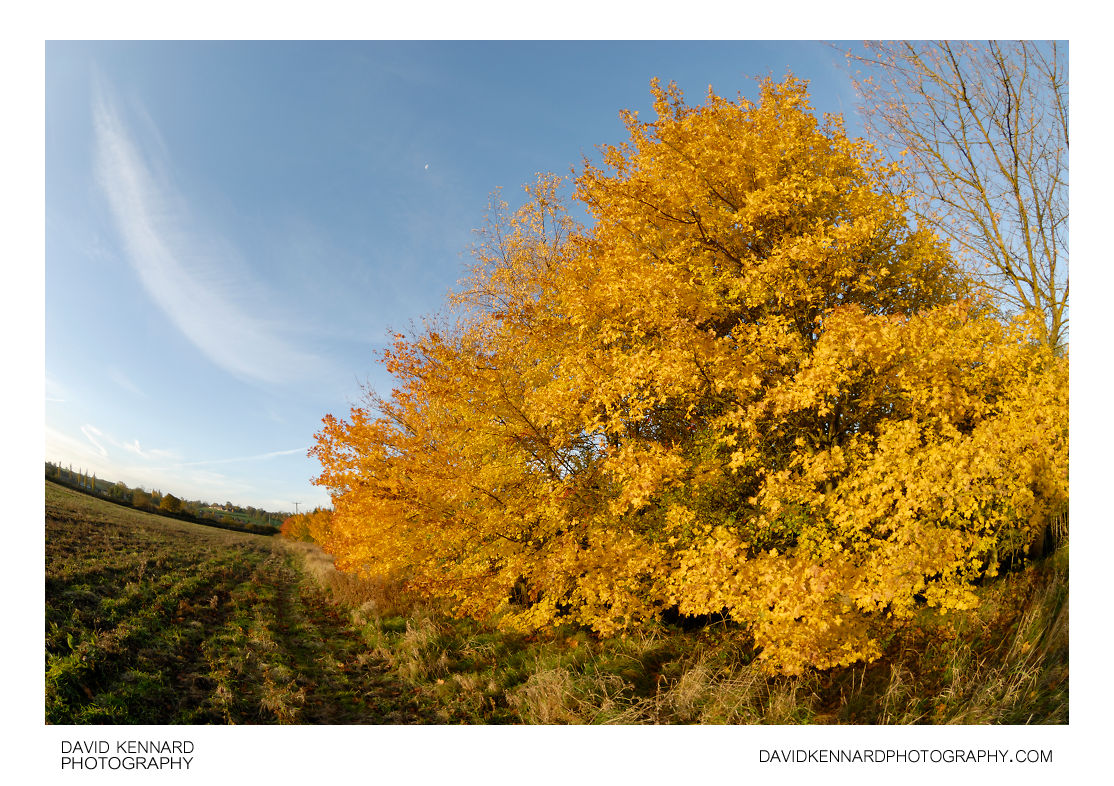Bright yellow autumnal tree

Description
- Title:
- Bright yellow autumnal tree
- Caption / Description:
-
A tree in bright yellow autumn colours on the edge of a field in Market Harborough, Leicestershire, UK.
From Wikipedia (http://en.wikipedia.org/wiki/Autumn_leaf_color):
Carotenoids are present in leaves the whole year round, but their orange-yellow colors are usually masked by chlorophyll. As autumn approaches, certain influences both inside and outside the plant cause the chlorophylls to be replaced at a slower rate than they are being used up. During this period, with the total supply of chlorophylls gradually dwindling, the "masking" effect slowly fades away. Then other pigments that have been present (along with the chlorophylls) in the cells all during the leaf's life begin to show through. These are carotenoids and they provide colorations of yellow, brown, orange, and the many hues in between.
The carotenoids occur, along with the chlorophyll pigments, in tiny structures called plastids within the cells of leaves. Sometimes they are in such abundance in the leaf that they give a plant a yellow-green color, even during the summer. Usually, however, they become prominent for the first time in autumn, when the leaves begin to lose their chlorophyll.
Carotenoids are common in many living things, giving characteristic color to carrots, corn, canaries, and daffodils, as well as egg yolks, rutabagas, buttercups, and bananas.
- Tags / Keywords:
-
- Europe
- UK
- Britain
- England
- East Midlands
- Leicestershire
- Market Harborough
- Countryside
- Yellow
- Farndon Fields
- Autumn
- Fall color
- Autumn colour
Admin
- Date Original Photo Taken:
- Original File Name:
- _DSC1973.NEF
- Event:
- Rating:
- ☆
- Date this image added/last updated on website:
- Original File Dimensions:
- 3872px x 2592px
- File Type:
- JPEG
- Color Mode:
- RGB
- Original Image Color Profile:
- Nikon Adobe RGB 4.0.0.3000
Location
- Location Shown:
-
- Sublocation:
- Farndon Fields
- City:
- Market Harborough
- Province/State:
- Leicestershire
- Country:
- United Kingdom
- World Region:
- Europe
- Location Created:
-
- Sublocation:
- Farndon Fields
- City:
- Market Harborough
- Province/State:
- Leicestershire
- Country:
- United Kingdom
- World Region:
- Europe
- Geo-location:
- 52.468993323633, -0.94038319482778 View on map
Rights
- Copyright Status:
- Copyrighted
- Licensing Status:
- Rights Managed
- Available for Editorial Use:
- Yes
- Available for Commercial Use:
- No
- Copyright Notice:
- © 2010 Dave Kennard
Camera Data
- Date Digital Resource was created:
- Shutter speed:
- 1⁄30 s
- Aperture:
- f/8
- Camera Model:
- Nikon D200
- ISO:
- 100
- Exposure Compensation:
- 0
- Focal Length:
- 10mm
- Focal Length (35mm equiv.):
- 15mm
- Metering Mode:
- Multi-segment
- Flash:
- No Flash
- Exposure Mode:
- Manual
- White Balance:
- Manual
- Light Source:
- Cloudy
- Exposure Program:
- Manual
Additional shooting metadata
- Lens:
- Tokina ATX107 DX FishEye 10-17mm F3.5-4.5
- Filters used:
- Additional Optics used:
- Setup:
- Benro C-428 Tripod
Markins M10 Ball head
Shutter release cable
Post Processing
- Image Modified:
- Software used:
-
- Nikon Capture NX 2
- Post Processing:
